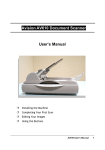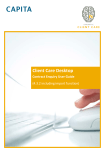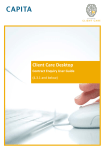Download Service Manual
Transcript
SAMPLE COPY Service Manual Shadow Investment SAMPLE COPY Contents Disclaimer3 Introduction4 Personal Message from Paul Sutherland, Managing Director of ISACO Ltd 4 Introduction to Shadow Investment 5 Part 2 – Investment Guidance – ‘Shadow Investment’ 6 How it works 7 Daily Market Updates 12 The Big Picture 15 FAQs16 2 Service Manual 2013 SAMPLE COPY Disclaimer Copyright The information provided is based on ISACO Ltd’s research and does not constitute financial advice. Any information should be considered in relation to specific circumstances. ISACO Ltd does not make personal recommendations of particular stocks, investment funds or any other security or investment of any kind. If particular stocks or investment funds are mentioned, they are mentioned only for illustrative and educational purposes. © ISACO Ltd 2001-2013 YOU SHOULD SEEK ADVICE FROM A REGISTERED FINANCIAL PROFESSIONAL PRIOR TO IMPLEMENTING ANY INVESTMENT PROGRAM OR FINANCIAL PLAN. ISACO Ltd and its employees are not agents, brokers, stockbrokers, broker dealers or registered financial advisers. ISACO Ltd does not guarantee any results or investment returns based on the information in this manual. Past performance is no indication or guarantee of future results and the value of any investment you make can go down as well as up. ISACO Ltd does not accept any responsibility for loss occasioned to any person acting or refraining from acting as a result of information contained in this manual. This manual presents information and opinions believed to be reliable but the accuracy cannot be guaranteed. ISACO Ltd is not responsible for any errors or omissions. All rights reserved. No part of this manual may be reproduced, re-recorded, stored in a retrieval system or transmitted, in any form or by any means, electronic, mechanical, photocopying, recording or otherwise without the prior written permission of ISACO Ltd. All copyrights reserved. ISACO Ltd is authorised and regulated by the Financial Services Authority. (FSA 525147) 3 Service Manual 2013 Stephen Sutherland and Paul Sutherland have asserted their moral rights in accordance with ss. 77–80 of the Copyright, Designs and Patents Act 1988. Published by ISACO Ltd. All rights reserved. No part of this publication may be used, reproduced or transmitted in any form without the prior written permission of the copyright owner. Any use of materials in this manual including reproduction, modification, distribution or republication without the prior written permission of ISACO Ltd is strictly prohibited. Applications for the copyright owner’s written permission to reproduce any part of this publication should be addressed to: ISACO Ltd, ISACO House, 82 King Street, Manchester, M2 4WQ, England. Telephone 0800 170 7750. Email [email protected] Warning – the doing of any unauthorised act in relation to this copyright work may result in both a civil claim for damages and criminal prosecution. SAMPLE COPY Introduction Hello, Welcome onboard My name is Paul Sutherland and as the Managing Director of ISACO, I wish you the warmest of welcomes. This service manual is split into two parts. The first part is written by my brother Stephen and the second part by me. In Part 1, The Investment Strategy, Stephen explains our investment strategy in simple language. Absorbing this information will help you to ‘think’ like we think and help you over time to adopt a leading investor mindset. In Part 2, Investment Guidance - Shadow Investment, I explain everything you need to know about Shadow Investment. I’m sure you are aware that ISACO aims to forge strong, long-term relationships with our clients and when we say ‘long-term’ we mean for life. ISACO’s aim is to guide you with your ISA and pension investing for the rest of your natural life and to guide future generations of your family for the full extent of their lives too. This means as time progresses, we are going to get to know you and your family on a personal level and hopefully we’ll eventually become close friends. Shadow Investment is premium and unique. No other financial services firm in the UK offers such a service specifically aimed at affluent ISA and pension investors. As you are aware, the service allows you to look over our shoulder and buy into exactly the same funds as we are buying. This means you can ‘shadow’ us and achieve the same returns we get. However with Shadow Investment being new to you, I respectfully ask you to give it at least five years before passing judgment on whether or not it works. When investing in the stock market, anything under five years is not enough time to make a fair appraisal. 4 Service Manual 2013 When it comes to investing, if you are not already a long-term thinker then this is the time to start. Thinking long-term is the key to becoming hugely successful with investing in the stock market. Think about the stock market as a vehicle you are going to invest in for life. The stock market is one of the best wealth generators in the world but only when it’s viewed as an investment vehicle for fifty years plus. Amateur investors make the fatal mistake of thinking too short-term with most falling into the get rich quick mentality. That’s why my advice to you would be to make a commitment to investing in the stock market for life and I promise that it will be one of the best financial decision you’ve ever made. My friend, I look forward to the day we celebrate the achievement of your ISA and pension goals, helping to create a substantial tax-free income for you and your family for life. Yours truly, Paul Sutherland Managing Director SAMPLE COPY Introduction to Shadow Investment As well as being ISACO’s Managing Director, I’m also known as the creator of the ‘Shadow Investment’ concept. The story began in 1998. After reading a book on how to improve your life, my brother Stephen decided he no longer wanted to work for our family cleaning and maintenance business and instead wanted to switch careers and become a professional stock market investor. He set a goal to become one of the best investors in the UK. His strategy for achieving his aim involved learning the secrets of the best traders in the world. On his journey, Stephen studied stock market legends such as Warren Buffet, Peter Lynch and Jesse Livermore and soon enough came across one legend that he became very excited about. His name was Bill O’Neil. Bill O’Neil is a leading authority when it comes to the stock market. As well as building a multi-million dollar business around his unique investment philosophy, O’Neil made a 2000% plus gain on his portfolio in just 26 months. Over his investing career O’Neil has mastered a way to effectively time the stock market. The market timing method O’Neil uses works approximately 80% of the time and it has helped him catch the start of every single bull market in the last fifty years. As you can imagine, the high predictability of accurately timing the market was one of the reasons Stephen fell in love with Bill’s investment philosophy. Stephen totally immersed himself in O’Neil’s thinking and ideas. Stephen aggressively read all of O’Neill’s books, as well as all of the books O’Neil had read and listened intently to all of his audio programs. He also subscribed to his premium equity research package. You could say that Stephen became one of Bill’s disciples. He flew across the Atlantic twice to see him in person, allowing him to learn direct from the master. I will never forget the day Stephen excitedly realised how this highly effective market timing method could be used for ISA and pension investing. 5 Service Manual 2013 Stephen’s breakthrough idea was to use O’Neil’s timing method to trade quality investment funds using a Stocks and Shares ISA or a personal pension, such as a SIPP. Using your ISA and pension, the aim is to make gains in up markets and protect in down markets. By using tax-efficient wrappers like Stocks & Shares ISAs, it gives you an edge and helps you to gain a much better chance of beating the market over the long-term. Sometime during the early years of the 2000s, I remember explaining to Stephen my frustration with getting poor investment returns. I shared with him how I’d been making all of my own investment decisions due to not trusting financial advisers, and I also explained that I didn’t have the time or desire to become a full time trader. I was in a bit of a tricky situation because I wanted to get the same returns as Stephen, but at that point, I didn’t want to put in the same amount of time he was putting in. Whilst I was pondering on how I could overcome this challenge, all of a sudden, I had an idea. I said to Stephen, “Stephen, how do you feel about me copying you?” I continued, “I want to get the same returns as you. Would you share what investments you are buying and selling and tell me the day you are doing it?” Stephen immediately said yes and from that day I’ve had the privilege of following him and achieving the same returns that he’s been getting. Because shadowing Stephen was so effective, easy and very time friendly, one day I realised there must be thousands of people like me who are also frustrated with their investment returns and need help. I asked the question, “How could other people shadow Stephen?” And this was the day Shadow Investment was born. SAMPLE COPY Part 2: Investment guidance ‘Shadow Investment’ 6 Service Manual 2013 SAMPLE COPY Paul Sutherland How it works Shadow investment gives you the opportunity to look over our shoulder and buy into exactly the same funds as we are buying. Your Chief Aim – Beating the Market The main objective of Shadow Investment is to help you beat the market. At ISACO, when we say beating the market, we mean beating the Nasdaq Composite which is arguably one of the strongest market indexes in the world. However, when referring to ‘beating the market’, most people are usually talking about beating the performance of the FTSE 100 or the S&P 500. Staying ahead of the FTSE 100 or the S&P 500 is no easy task. However, in the past they have both been easier to beat than the Nasdaq Composite. ISACO’s philosophy is the indexes that have proved strong in the past will probably remain strong in the future and the indexes which have lagged in the past will probably continue to lag in the future. Name of index Dow Jones Industrial Average S&P 500 Nasdaq Composite (US technology index) Long-term performance average annual gain 12.4%* 13%* 18.3%* * Period taken January 1st 1975 to December 31st 1999. Source: Yahoo! Finance. 7 Service Manual 2013 SAMPLE COPY NASDAQ Composite S&P 500 NASDAQ DOW Apr 27, 2012 +4000% +3000% +2000% +1000% 0% 1975 1980 1985 1990 This chart shows how the Nasdaq Composite has performed versus the Dow Jones Industrial Average and the S&P 500. As you can see, the Nasdaq is the clear winner. FTSE 100 ^FTSE 1995 2000 2005 2010 But how has the Nasdaq Composite performed versus the FTSE 100? As you can see on this next chart, since 1984 the FTSE 100 made 400% over the same period, however; the Nasdaq is the clear winner after making close to a 1000% gain over the very same period. NASDAQ Apr 27, 2012 +1500% +1000% +500% 0% 1985 1990 1995 Aiming to beat the Nasdaq would therefore be a much harder goal than trying to beat the Dow, the S&P 500 or the FTSE 100. Beating a strong market index like the Nasdaq Composite is not easy to do, and most fund managers find it hard to beat the FTSE 100 and the S&P 500. But some investors have proven that beating the Nasdaq is possible. 8 Service Manual 2013 2000 2005 2010 In summary, you need a benchmark index as a target and having a benchmark such as the Nasdaq helps you measure how well you are doing with your investing. If you don’t measure, you can’t manage. It’s that simple. SAMPLE COPY Aims and Expectations As you’ve just learned, the ultimate objective is to beat the Nasdaq Composite and that is what Shadow Investment has been designed to do. There are no guarantees that we will beat it but to beat the Nasdaq is the aim of the service. What gains will you make? The answer to this one all depends on four factors. If you have read Stephen’s book Liquid Millionaire, you will have been introduced to The Performance Quadrant. The Performance Quadrant Internal (in your control) Investment Vehicle External (out of your control) Market Direction The performance quadrant can help you quickly determine how much money you are likely to make in any given period of time. How much profit you will make in any length of time will always depend on four factors. By discovering how the performance quadrant works, you will realise that when making money in the stock market, there are some things that are in your control and others that aren’t. Let me explain: Many potential clients ask me: “When shadowing you, what sort of returns will I make over the term of my investment term?” I always reply with… “I have no idea.” The good news is that two of the components of the performance quadrant are in your control. The bad news is that two of the components are out of your control. Because there are two elements ‘out’ of your control, it is literally impossible to predict how much money you are likely to make. Let’s have a look at each part of the performance quadrant because all four parts determine in some way how much cash you will make. Market Timing 9 Service Manual 2013 Market Strength SAMPLE COPY Investment vehicle The first part in the quadrant is the investment and by this I mean investments funds. This is in your control and the aim is to choose high quality investment funds. Market Timing The second part in the performance quadrant is market timing. This, is also in your control. This is when you aim to invest when the market is in an upwards trend and move out of the market when the upwards trend changes into a downwards trend. This second key part in the performance quadrant tells you that even if you pick the very best investment vehicle, if you get your timing wrong, your investment returns could be affected. Now you have seen what is in your control, let’s take a look more closely at the two things that are out of your control. Here is the quadrant again to remind you: 10 Service Manual 2013 The Performance Quadrant Internal (in your control) External (out of your control) Investment Vehicle Market Direction Market Timing Market Strength SAMPLE COPY Direction The third part of the performance quadrant is direction. Market direction is ‘out’ of your control and it is impossible to will the market upwards. And if it does not go up, funds are not going to go up either. The rule is: three out of every four stocks – and investment funds – move in the same direction as the market. That tells you the returns of the funds you choose throughout your investing career will be directly linked to the market’s direction. If the market is trending upwards, three out of every four funds will move up. If the market is trending downwards, funds are going to move down. And if the market is trending sideways, they are going to move in which direction? Yes, you are correct, sideways. Collectively, this indicates that if a client invested for a five year term and the market over the next five years went sideways, how much money is this person likely to make? If you said nothing or very little, you would be correct. The good news is that in a sideways market, even though most investors lose money, we aim to make a return of around 3-5% per year. 11 Service Manual 2013 Market Strength The fourth and final part of the performance quadrant is market strength. The ‘strength’ of the markets trend is also out of your control? If the market is trending upwards and the trend is strong, fund performance will be impressive. For example in 1999, the Nasdaq went up 86% in one year and in that very same year, investment funds were moving up 100%, 200%, 300% and even 400% in just one year. The rule is: quality investment funds make substantial gains when the market is strong. Hopefully now you will be able to see the link between the fund you buy, the market direction and the market’s strength. With this in mind, we have different aims for different market environments. His aims are based on a period of between five and fifteen years. • Sideways trending market: The aim is 3%-5% per annum. • Upwards trending market: The aim is 12%-15% per annum. • Very strong upwards trending market: The aim is 15%-20% per annum. SAMPLE COPY Daily Market Updates Each update is written by ISACO’s Lead Investor and Chief Investment Strategist, Stephen Sutherland and he writes each update the morning after the stock market closes. The market opens Monday to Friday and is closed for weekends and therefore your Daily Market Update lands in your inbox Tuesday, Wednesday, Thursday, Friday and Saturday every week throughout the year. On the non weekend days that the market is closed, such as National holidays, you receive an update reminding you the markets were closed. Each update arrives in your email inbox before the opening bell for the US markets (GMT 2.30pm). Even though we keep an eye on all the world exchanges, our main focus when we write each update is with the US markets. The reason is: • The US is the world’s largest economy and the leading market to watch for clues of future direction • The US stock market indexes long-term growth exceeds other world exchanges • The essence of our philosophy involves watching price and volume behaviour of institutional investors on the US markets. 12 Service Manual 2013 Daily Market Updates have been designed so you can quickly scan the information and take action – if you feel the need. For example, if we were placing a trade, you have the opportunity to place an identical trade in your own account. Why reading your updates every day makes sense Aim to make it a habit of reading your updates day in day out. When you read our updates every day, and decide to act on the information presented, you’ll have the best chance of achieving almost identical investment results to the ones we get. It’s important to read your Daily Market Update every day because a piece of positive or negative news such as an unexpected event could change the whole dynamic of the market in the space of a single day. Dependent on how the market responds to the news will ultimately govern how we react. This means the market’s health and direction could alter in the space of 24 hours which is why investors should remain vigilant at all times. Investors who take their eye off the market may miss out on the opportunity of ‘getting in’ when a new uptrend has been established. When you get in early, you have the potential of profiting from exciting investment opportunities but when you fail to get in early you could miss out on strong investment returns over relatively short time frames. SAMPLE COPY The threat of getting locked into a falling market Another reason to read your updates every day is because investors who fail to keep a close eye on the market could unfortunately get locked into a falling market, missing the chance to ‘get out’ when a downtrend has been triggered. This could result in unnecessary loss – losses that could have been avoided by a more diligent follower of the updates. For example when we spot what we believe to be a market top, we move into an ISA Cash Park to protect and preserve our wealth. Clients who study our daily movements will also have the opportunity of replicating our trade by moving into cash at exactly the same time as we are moving into cash, helping to preserve their wealth too. Missing a switch could prove to be a costly mistake Another reason to read your updates on a daily basis is because of staying ‘in sync’ with our fund choices throughout the year. For example, we generally make about one or two trades a year and those switches to the funds we own in our portfolio could happen at any given time. If you ever missed out when we were making a switch, it would mean not achieving the same returns as we get. It could also mean missing the opportunity to get into a fund just before it has an explosive breakout move to the upside. 13 Service Manual 2013 Why it pays to watch what the big players are doing Five days per week you’ll discover what our stance is on the market. You’ll see if our stance is ‘healthy’ or ‘unhealthy’. If we class the market ‘healthy’, it means we will be invested. On the other hand, if we believe the market is unhealthy, we will be temporarily parked in an ISA Cash Park. The stance we take on the market is created by our daily analysis of the market indexes and leading stocks. Our in-depth intraday look at the market is followed by a thorough after-market check up. The concluding results are reported and published in the Daily Market Update. When dissecting the market, price and volume behaviour from institutional investors are our primary indicators. We use price and volume action to help us determine the market’s health and likely future direction. The price and volume behaviour of leading stocks is our secondary indicator. Our opinion of the market’s health is published in each update. If we believe it’s healthy, it means we’ll probably be in a bull market or just about to enter one. In bull markets, markets rise and because 75% of stocks move ‘in sync’ with market direction, this is why we invest – upwards trending markets are the safest time to invest. If our stance on the market is unhealthy, we believe we are in a bear market or just about to enter one. Investing when we are in a bear market (downwards trend) is not a good idea when invested in leading investment funds. In bear markets, markets drop and 75% of stocks drop too – the reason why we temporarily park our ISAs in an ISA Cash Park. SAMPLE COPY A closer look Let’s have a look at a Daily Market Update. Each market update starts by stating clearly what our opinion is of the current health of the market (Point A). Next in the ‘Market Indexes’ section you’ll see a table (Point B) that shows price and volume changes of the four US market indexes we follow. On the left hand side, you’ll see a section called ‘Market Action’ (Point C). In this section you get our opinion on the previous day’s behavior. You’ll discover if we liked the action and explain why we thought the action was good, neutral or not good. In ‘Market Action’ we tend to focus on the price and volume action of the Nasdaq Composite and also frequently comment on the Nasdaq 100, the S&P 600, and the semiconductor sector. The reason is we believe these are all leading indicators. On the right hand side of your update, you’ll see a section called ‘Leading Stocks Action’ (Point D). When we analyse leading stocks, we look very carefully at how the stock has acted for the day and calculate what percentage of the leading stocks acted healthy versus unhealthy. Ideally we like to see 80% of the leaders acting healthy. In the next and final section called ‘Shadow Investing Intelligence’ (Point E) you discover what we are invested in right now and our current asset allocation. Let me close with one very important point. Please understand that the market can turn and change direction in a matter of days. This is why daily monitoring is so important. That’s why aiming to create the habit of reading your updates every day is vital and will help to maximize the probability of you attaining almost identical returns to the ones we get. A Friday 30th March 2012 Index Change C Volume Change to its Average Volume Compared Type of Day NASDAQ -0.31% +0.1% Below average Bullishly reversed off lows S&P 500 -0.16% -0.7% Below average Bullishly reversed off lows S&P 600 -0.25% -13.6% Below average Bullishly reversed off lows +0.15% -0.7% Below average Bullishly reversed off lows DJIA Yesterday’s market action was positive. Leading Stocks Acting Healthily 73% The Nasdaq Composite dropped for the third day in a row, losing 0.31% in similar volume to the previous day. However, with the Nasdaq experiencing a reversal, it appears it may have support at 3070. Leading Stocks Acting Unhealthily 27% It was good to see the chip sector outperforming the market. This is always a bonus especially with chips being the heart and the soul of the Nasdaq. For now the SMH appears to have solid support at the $35 level. 14 Service Manual 2013 Leaders performed well. 73% of leaders (Below the 80% number we like to see) acted healthy versus ones that acted unhealthy. On Saturday 21st January 2012 I made two switches. If you are curious to ‘why I made the switch’ click here for a full explanation. I am invested in the four funds below. B D E SAMPLE COPY The Big Picture The Daily Market Updates focus on the short-term activity and The Big Picture focuses on long-term. The Big Picture contains more information than the Daily Market Updates and is published once per month. With The Big Picture containing more information than Daily Market Updates, it takes about ten minutes to read. Just like the Daily Market Updates, aim to make it a habit to read The Big Picture every month. The Big Picture Each issue of The Big Picture will contain the following sections: Shadow Investing Intelligence • The Big Picture; • Market Indexes; • Shadow Investing Intelligence; • Current Health of the Market; • Summary. The information in this section helps you to think like a professional investor. It is full of detailed charts, investor lessons and key insights. You discover our investment outlook which involves sharing with you whether we believe we are in a bull market or a bear market and how long the trend is likely to last. You’ll also discover what events over the last four weeks have caught our attention and what they mean to you as an investor. Market Indexes Here you get a detailed table showing you how each main index has performed during the month and whether the behavior was good, neutral or not good. In this section you’ll see what we are currently invested in plus our current asset allocation. Current Health of the Market You’ll learn what our current stance is on the market and get a brief summary of what happened each week during the month. Summary We conclude with a summary to help drill home key points. This is handy to view when you don’t have the time to read the full update in more detail. 15 Service Manual 2013 SAMPLE COPY Frequently Asked Questions (FAQs) Q: It appears to me that this service hinges on your performance. What would happen to the service if something ‘unexpected’ happened to your lead investor Stephen? A: We can assure you the contingency plan is in place should something unexpected ever happen. Stephen Sutherland is only forty three years old and plans to live to an age in excess of 100. He also plans to lead the team and provide guidance to ISACO’s clients until the day he dies. He takes extremely good care of himself which includes adhering to a very healthy diet and strict disciplined exercise program. However, accidents do happen and if anything unexpected did happen to Stephen, Steve Todd, ISACO’s Global Strategist would step in as a short-term substitute. Steve is an experienced market reader who has been successfully investing in the market since 2000. Steve has been working with Stephen side by side since 2003 and they share the same investment philosophy. Steve also helps Stephen with the writing and publishing of the Daily Market Updates and The Big Picture. As a long-term solution, Paul Sutherland, ISACO’s Managing Director would find a suitable replacement for the Lead Investor role. The replacement would be a leading investor who has demonstrated an outstanding long-term track record and have a six-figure plus ISA and pension portfolio. 16 Service Manual 2013 Q: What is the best way to get one to one help with answering any questions I have? A: Simply contact Paul Sutherland. His email is [email protected] and his telephone number is 01457 831 642. When you get hold of Paul you can arrange a time to speak convenient to both of you. Q: What kind of annual gains can I expect to make during the investment guidance term? A: The gains you will make depend on four factors. Two of these factors are in your control and two are out of your control. The ‘investment vehicle’ you choose and your ‘market timing’ are in your control. The ‘market direction’ and ‘market strength’ are out of your control. This means we have different aims for different market environments. These aims are based on a period of between five and fifteen years. 1. Sideways trending market: the aim is a 3%-5% return per annum. 2. Upwards trending market: the aim is a 12%-15% return per annum. 3. Very strong upwards trending market: the aim is a 15%-20% return per annum. SAMPLE COPY Q: Are the expected returns guaranteed? A: No, nothing is guaranteed when investing in the stock market. Stock market investing is always based on risk versus reward. If your goal is to achieve double digit returns over the long-term, risk will always be associated with your investing. The way to lower the risk is by extending your time frame. It’s been proven that the longer the period you invest for, the higher the probability of achieving a positive return. Q: How will I know if these are good returns? Do I have a benchmark? A: With Shadow Investment, your aim is to beat the Nasdaq over the long-term. The Nasdaq Composites future long-term performance is your benchmark. Simply make a note of what the Nasdaq Composite is trading at on the day you start shadowing us. Also make a note of your ISA account value. If you have a pension you plan to use to shadow us, make a note of its value too. During your term, make a note of any additional capital you put in each year such as annual ISA additions. At the end of your term make another note of what the Nasdaq is trading at and how much your account is valued at. Calculate the percentage change over your investment period of the Nasdaq and your account. If your account has grown by a larger percentage than the Nasdaq over the time frame, it means you have beaten the Nasdaq which is classed as ‘success’. If you haven’t beaten it, it means you have underperformed the Nasdaq which is classed as ‘failure’. Q: What kind of returns can I expect from a flat sideways travelling market? A: This is the most difficult type of market to make money in. In these types of markets, we aim to achieve 3-5% per annum. Q: What kind of returns can I expect from a typical 5 year period? A: If the 5 year period is a sideways trending market, the aim is to make 3%-5% per annum. In an upwards trending market, the aim is 12%-15% per annum. In a very strong upwards trending market, the aim is 15%20% per annum. 17 Service Manual 2013 Q: What kind of returns can I expect from a strong 5 year period? A: The aim is 15%-20% per annum. Q: Can I expect to have any years when my portfolio is down? A: Yes, down years are all part and parcel of the longterm investing game. A full economic cycle lasts about five years and consists of a bull market (upwards trending market) and a bear market. Bull markets last 2-4 years and bear markets 9-18 months. That means, for every five year period invested, one or two of the years will probably be down years. Q: Is the goal for you to beat the Nasdaq Composite every single year? A: No, it’s to beat the Nasdaq over the long-term. Even though we aim to beat the Nasdaq every year, we know that it’s an almost impossible task due to the Nasdaq being one of the strongest indexes in the world. This means that during your subscription, there will be years when we underperform the Nasdaq. This is perfectly normal and natural. Q: What can I expect to happen to my portfolio just after beginning my term? A: Your portfolio could do one of three things. It could go up, down or move sideways. It may start up and then head south for a while before shooting northwards. On the other hand, it may start down initially and then reverse course and start heading higher. What normally happens is, during the first few weeks/months, your account will drop below the point you entered the market. This is perfectly normal and is due to the shortterm fluctuations from the stock market. Q: If you move into cash, does that mean that the market is guaranteed to go down? A: No. We do not have a crystal ball to tell us when the exact top of the market is. Our aim is to get out as close to the top of the market as possible however this is extremely difficult to achieve. SAMPLE COPY Q: What exactly is the ISA Cash Park and how does it work? A: For simplicity purposes, we will focus on Fidelity’s ISA Cash Park as this is the one we use to park our money in during bear markets. The Fidelity ISA Cash Park offers: • A temporary haven for your money while you decide where to invest. • An easy way to take a break from investing during volatile times. • Time to make your fund choice. • No charge for investing in or switching into ISA Cash Park. • You’ll pay a maximum of 0.25% when you switch from ISA Cash Park into your fund choice. • Preserves your tax-efficient Stocks & Shares ISA allowance. • Earn interest while your ISA money is held in ISA Cash Park. • Interest fixed at 0.4% below the Bank of England bank rate (subject to a 20% charge to HM Revenue & Customs). When you move money from the Fidelity ISA Cash Park into a fund you will pay a maximum of 0.25% switching charge. No charge will be made when moving money from the Cash Park into a fund that has no initial charge, although this will exclude funds where the standard initial charge has been reduced to 0% for a limited special offer period. Fidelity will retain some of the interest earned, typically at a rate of 0.4% of the balance. Fidelity can provide details on request. Money paid into the ISA Cash Park will be deposited with The Royal Bank of Scotland plc (RBS) by Financial Administration Services Limited. RBS is a member of the Financial Services Compensation Scheme (the FSCS), and money paid into the ISA Cash Park is protected deposits for the purposes of this scheme. If RBS were to fail, the FSCS can pay compensation up to a limit of £85,000 to each eligible claimant. An individual is an eligible claimant for the purposes of the scheme. For other types of eligible claimants, please refer to the FSCS website - www.fscs.org.uk. The compensation limit of £85,000 applies to all the accounts that the eligible claimant holds with RBS (whether they are a single or joint account holder). This means that if RBS were to fail and the eligible claimant 18 Service Manual 2013 had deposits exceeding £85,000 with RBS (including amounts held on the ISA Cash Park), then amounts over £85,000 would not be covered by the scheme. Q: Will I see growth in my account when invested in Fidelity’s ISA Cash Park? A: Yes, interest is fixed at 0.4% below the Bank of England bank rate (subject to a 20% charge to HM Revenue & Customs). Q: Can my account go down in value when parked in the Cash Park? A: No. Q: When we are in cash, how long are we likely to be sitting in cash? A: After being invested for between two and four years, there will be a period of between nine and eighteen months when we sit in cash. This is because bear markets tend to last between nine and eighteen months. Q: If after getting out of the market into cash, if the market starts to go back up, and you remain in cash, should I invest into a quality investment fund? A: It is entirely up to you. It is you that is in control of your account and not ISACO. If you believe we have made the wrong call on the market (which can happen), feel free to re-enter the market. Q: I have many ISAs set up in different locations. What is the best way to get organised so that they are all under one roof allowing me to manage them more effectively? A: We always recommend clients use Fidelity’s Fundsnetwork™. You can move your investments in one of two ways: re-registering your ISAs or transferring them. Re-registration With re-registration, your money stays invested in the same funds so there’s no need to make any investment decisions. Fidelity takes over their administration and you will not be out of the market at any point during the process. Re-registration is available for moving investments held within an ISA, where your tax allowances will remain unaffected. If your existing fund provider charges you an exit fee for re-registering your investments to us, Fidelity will refund the money to you. Call Fidelity’s freephone number 0800 0854 263 and they will help to sort it out. SAMPLE COPY Transferring ISAs If your fund company does not support re-registration you can transfer your funds. This involves selling the funds and buying new ones. Your current provider will sell your funds and send the proceeds to Fidelity for reinvestment. You can then tell Fidelity where you wish to reinvest your money. When the new funds are purchased there may be an initial charge, depending on the fund you choose. However, there are many funds, including all Fidelity funds, with no initial charge - although standard annual management charges will apply. It’s worth noting that you will be out of the market for a short time while the transfer goes through, and the value of your holding may be affected by any market movements. As with any investment, the value of funds - and the income from them - can go down as well as up so you may get back less than you invested. Q: I have a personal pension that I’d like to use to shadow you and I’d like to manage my account through a fund supermarket. How can I do that? A: ISACO recommends you do this through Fidelity’s FundsNetwork™. It’s an easy and simple 3 step process. Step 1 is to download an application form, step 2 is to make your fund choice, and step 3 is to post your application. If you need help, call Fidelity’s dedicated personal pension team on 0800 085 0923. Q: What happens at the end of my service term? A: You are reminded by email that your service term is coming to an end. If you’ve been delighted with the service and it’s met or exceeded your expectations, you’ll be able to continue receiving uninterrupted help and guidance from ISACO by simply investing with us for another term. If for any reason ISACO has not met your expectations, you can discuss your concerns with us. Because our goal is to help and guide you, your family and future generations of your family with your ISA and pension goals, if you are dissatisfied, we will do all we can to address your needs or concerns because your satisfaction of the service is our number one priority. 19 Service Manual 2013 Q: What happens if I am not at my financial target when my service term ends? A: Reaching an important financial goal in life sometimes takes longer than expected, especially if the market has not been in a strong uptrend over the course of your investment term. If you have not hit your goal in the time frame set, keep going! At ISACO we always say, it’s not a matter of if you will get to your goal but more a question of when. ISA and pension investing is for life and by adopting a long-term mindset you increase the probability of reaching your goal. Q: As I close in on my retirement age, is there a way of reducing the risk/volatility of my Stocks & Shares ISA/Personal Pension? A: Yes, there is a strategy called ‘lifestyling’ which is the practice of reducing the risk of an ISA or pension as you get closer to retirement age. The way this is done is by altering your asset allocation when invested in funds. When we invest during bull markets, we generally invest 100% into investment funds and 0% in cash. We will change this allocation when we believe we are about to enter a bear market, or when we believe we have just entered a new bear market. If you wanted to adopt a lifestyling strategy, instead of having a 100% invested in funds asset allocation, you could choose to have a lower percentage. For example, instead of being 100% invested, you could be 80% invested in funds and have 20% in either a Cash Park or a low risk bond fund such as Fidelity’s Moneybuilder Income Fund. If you were extremely risk averse and worried of short-term fluctuations, you could change your allocation according. You may want to be 50% invested and 50% in cash /bond fund. The percentage of how much invested versus how much in cash is entirely up to you and the decision will always be based on your risk profile. Q: What are the actions I should take when I reach my goal? How do I set up my account to pay me an income to help fund my lifestyle? A: When reaching a long-term target - which could be anything from £500,000 to £15 million or even more - set up an automatic withdrawal plan to pay for your lifestyle. The rule is to take out much less a percentage than the percentage rate your account is growing at. If you’d been making 10% per year and believed you could keep making 10% per year, withdrawing 4% or 5% per year would result in drawing out less than your money SAMPLE COPY is growing at which means your main pot keeps getting larger as you move through time. To set up such a plan, simply contact the company holding your investments (for example Fidelity) and explain your wishes. Q: When does it arrive in my inbox? Q: Why invest in investment funds instead of individual stocks? Q: Why do I need to make a habit of reading the Daily Market Updates every day? Why can’t you just send me an alert when you make a switch? A: Individual stocks carry more risk and are more volatile. A stock can fall as much as 50% or more in one day which means if your total ISA and pension pots were invested in just one company, your risk of a huge loss is high. In fact, if you only own one stock and the company goes into liquidation, your accounts could drop to zero. Investing in just one company with your full portfolio carries way too much risk. Investment funds on the other hand own a large number of stocks which helps reduce the risk and volatility. Q: Are the investment funds that you are invested in going to be liquid enough to allow successful buy and sell transactions for all the people who are shadow investing? A: Yes, we make sure that the funds we invest in are liquid enough to allow successful buy and sell transactions for all the clients shadowing us. Q: Is HIRE CAR™ a fund screening software program? A: HIRE CAR™ is not a software program. Instead it’s a 7 step checklist that we use to find and buy quality investment funds. Q: Each and every year are you always going to pick funds that turn out to be the number one fund of the year? A: No. We choose funds to invest in that we believe have a high probability of outperforming the Nasdaq Composite. Some of the funds we choose may turn out to be big winners and others may turn out to be not be as successful. Q: How many Daily Market Updates do I get? A: The stock market is open five days a week which means you receive five updates per week. In a typical year, you get two hundred and forty one Daily Market Updates. You receive your updates on Tuesday through to Saturday. Your first one of the week arrives on Tuesday morning and provides you with our opinion on Monday’s market activity. In Wednesday’s update, you will receive commentary on Tuesday’s session and so on. 20 Service Manual 2013 A: Your Daily Market Updates arrive in your inbox before the opening bell for the US markets (GMT 2.30pm). A: The updates help you to think like a high caliber trader and before a switch takes place, we let you know that we are thinking of making a switch in the up and coming days/weeks. This helps you to get prepared and ready for the big day. We strongly recommend clients aim to read their updates every day because this is the best way to achieve almost identical investment returns as the ones we are getting. The market’s health and trend direction can change in a matter of days especially when institutional investors become aggressive on either the buy side or the sell side. Big news events can often trigger such aggressive reactions. The market’s health and trend direction can change in a matter of days, especially when institutional investors become aggressive on either the buy side or the sell side. Big news events can often trigger such aggressive reactions. If a client doesn’t read their updates, they could miss a move or, in the worse-case scenario, leave themselves exposed to a big fall in their account. This is why it’s best to read your Daily Market Updates every day and with the updates taking only taking a few minutes to read, it’s easy to make this time friendly task an established habit. Q: How do I keep up with your movements when I travel/go on holiday? A: If you are travelling to a place where they have internet connectivity, you can check your updates through a business centre, an internet café, a laptop or another mobile device such as a Blackberry, a smart phone or a tablet computer. If you are travelling where you will be offline you can either delegate your shadow investing activities to a person you trust back home, or you could come out of the market into cash knowing that your account will not be at risk. SAMPLE COPY Q: What are the differences between the Daily Market Update and The Big Picture? A: Both are written by our Lead Investor Stephen Sutherland. However, The Daily Market Updates focus on the short-term and The Big Picture focuses on the longterm. Daily Market Updates keep you informed on a daily basis exactly what we are investing in so that you can do the same. The Big Picture contains more information than the Daily Market Updates and is published once per month Q: Who controls my account? Is it you or me? A: You control your account. Q: Can I give control to you? A: No. ISACO’s level of FSA regulation does not permit holding client money. Q: How do I make a switch? Q: Do you get it right all the time? A: No, we tend to get it right about 80% of the time. Q: Why do I need to know about investment psychology? After all, all I have to do is follow your lead, right? A: There are four emotions that drive stock market investors: hope, fear, greed and pride. Each day - you as an investor - will have to battle with these emotions. To help you manage your emotions, we’ve put together our top ten tips: 1. Think long-term. 2. S ee losses as temporary paper losses and as a minor inconvenience. 3. L ook at losses as a percentage loss rather than a pound note loss. A: Making a switch is easy. If you use Fidelity’s FundsNetwork™ like we do, in the section called ‘Your accounts and dealing’ click on ‘Dealing & new accounts’. After you click through it is self-explanatory. As an alternative, call your fund supermarket provider. Fidelity can be contacted by calling a freephone number which is 0800 41 41 61. 4. Look at your account value once a year. Q: How difficult is it to time the market accurately? 6. S hadow us for at least five years before making judgment on the quality and effectiveness of the service. A: It is extremely difficult. We tend to get it right about 80% of the time. In a typical cycle our aim is to get in just before a new bull market begins or just after it’s started. Our aim is also to get out of the bull market when we believe it’s run its course which is typically two to four years in length. During a bull market, there will be lots of correction periods. In a bull market, we do not try to time the getting out and getting back in of these corrections because of the difficulty in doing so. Our investment philosophy is, stay fully invested during bull markets and get out of the bull market when we believe it’s run out of steam. This is when a new bear market has begun. When the bear market is over, we aim to re-enter the market. This bull bear cycle continues forever. 5. R ead books such as Mastering Trading Stress by Ari Kiev and Stress Management for Dummies by Alan Elkin. There are other suitable publications recommended in appendix 2, found at the back of this service manual. 7. U nderstand how The Performance Quadrant works. Remember, if the market moves sideways - or down you are probably not going to make any money. 8. D on’t compare. Amateur investors use hindsight to their disadvantage. They beat themselves up with “if only…” scenarios. 9. D evelop patience. Retiring financially secure takes time. You need to exercise patience for specific periods in the market cycle such as when sitting in cash during bear markets. There will be other times when patience is required. For example, when you first invest into the same fund that we are investing in you can often find yourself in a situation where your investment fund heads south before eventually heading higher. 10. Accept that we are human and that sometimes we will make mistakes. 21 Service Manual 2013 SAMPLE COPY Q: I have a Personal Pension / SIPP that I’d like to use to shadow you. How do I do that and is it any different from shadow investing using ISAs A: First of all it is possible to use either a Self Invested Personal Pension (SIPP) or a personal pension to shadow us. It is important however to know the differences between these two wealth building vehicles. The big difference between pensions and ISAs is when you get your tax benefit. With a pension, you make contributions out of your pre-tax earnings, but get taxed on the income when you draw your pension. With an ISA, you contribute out of your post-tax earnings, but get tax benefits on any income that you take from it. ISAs are liquid. That means you can get at your cash whenever you want .However with pensions, once money has gone in, it can’t come out until you reach 55 years of age and then it’s taxed. If you want to shadow invest using a pension, you simply do it in the same way that you would shadow invest using ISAs. Depending on what type of personal pension you have will depend on the range of fund choice and the type of Cash Park available. If you do decide to use a pension to shadow us, and you find that the funds that we are investing in using our ISAs are not available for you to invest in using your pension, you will need to find similar alternatives. If you need assistance, we will point you in the right direction. Q: Who is shadow investing suited to best? 1. S hadow Investment is suited to adventurous investors with an appetite for risk with a long-term investment horizon. Five years is the absolute minimum. 2. It’s suited to people who are willing to sacrifice shortterm volatility for the aim of long-term double digit capital growth. 3. T he service is ideal for people who have other assets in place in case the stock market underperforms. 4. T he service is for people who have built up a certain level of wealth. It’s normally more suited to mature people rather than individuals just starting out. 22 Service Manual 2013 5. It doesn’t normally work for people who have less than a £50,000 portfolio unless they have intentions to add the full ISA allowances each and every year for themselves and for their partner – for at least a five year term. 6. T he service is not for ‘get rich quick merchants’. It’s aimed at people seeking reasonable long-term capital growth. 7. T he service suits people with a long-term capital growth strategy who plan to draw income from their account once their target has been reached. 8. T he service is for people who are used to thinking long-term when it comes to investing in the stock market. It’s for people who already have a decent understanding of how the stock market works and understand how difficult it is to time the market. 9. T he service is aimed at people who fully appreciate how difficult it is to ‘beat’ the market. It’s for individuals who understand that the stock market is like a rollercoaster with lots of ups and downs during the journey. 10. The service is for people who understand the importance of not becoming emotional about gains or losses and that the ideal emotional state for a winning investor is to stay neutral. 11. The service is aimed at people who can be patient for five years before judging the service. 12. The service is aimed at people who have patience and can comfortably sit temporary in cash when bear markets arrive. Sitting out of the market on the sidelines for periods up to eighteen months in length is too much for some people. However, sitting in cash for extended periods is part of the service. 13. The service is for people who agree with our investment strategy. 14. T he service is aimed at people who have seen our track record and believe 100% in our investing ability. 15. The service is ideal for people who have faith that we are making the right decisions most of the time and that those decisions will ultimately help them to beat the Nasdaq Composite and the FTSE 100 over the long-term. SAMPLE COPY 16. T he service is for people who understand how the market performs will directly impact their results. 17. T he service is for people who understand that the chief aim is to ‘beat’ the Nasdaq and the FTSE 100 and not to pick the number one fund each and every year. 18. T he service is for people who see temporary ‘paper’ losses as percentage losses rather than pound note losses. 19. T he service is aimed at people who have the faith and discipline and enough capital to keep adding the full ISA allowances each and every year for themselves and their partner. 20. The service is perfect for people with mental strength who can ignore the ‘noise’ from the financial media. 21. The service is aimed at people who like infrequent trading and condensed time focused information. Typically, there are only one or two trades to make over a twelve month period. Daily Market Updates are designed with this time friendly nature in mind and take just minutes to read. 23 Service Manual 2013 Appendices Appendix 1 – ISA History ISA History January 1, 1987 - General PEP introduced by Nigel Lawson, Calendar Year allowance of £2,400. January 1, 1988 - General PEP allowance increased to £3,000 April 6, 1989 - General PEP allowance moves from calendar year to tax year and allowance increased to £4,800. Investors enjoy both the 1989 £3,000 calendar year allowance and the new £4,800 tax year allowance. April 6, 1990 - General PEP allowance increased to £6,000 April 6, 1991 - Norman Lamount announces the introduction of the single company PEP allowance of £3,000 alongside the general PEP allowance, bringing the total amount that can be sheltered in any one tax year to £9,000 from January 1992 April 6, 1999 - Gordon Brown introduces ISAs to replace PEP allowances. Dividend taxation also changes - the tax credit attached to dividends falls to 10%. ISA and Pep managers can reclaim this tax credit. The ISA allowance is £7,000. April 6, 2004 - ISA and PEP managers are no longer allowed to reclaim the 10% tax credit attached to dividends. This leaves ISA investors £10.00 worse off for every £100.00 gross dividend paid. December 2, 2004 - The Chancellor announces in his pre-budget speech that he intends to maintain the annual ISA allowance at £7,000. The allowance had been due to fall to £5,000. March 15, 2005 - The Chancellor announces in his budget speech that the £7,000 ISA tax-free savings allowance will be extended to 2010. 24 Service Manual 2013 November 2006 -The Economic Secretary to the Treasury, Ed Balls MP, announced the largest ever reform package to the ISA regime. The reform package includes a commitment to a permanent future for ISAs beyond 2010, the removal of the mini/maxi distinction, the rolling of PEPs into the ISA wrapper and the rollover of some existing savings vehicles, such as Child Trust Fund on maturity, into ISAs. November 2006 -The Economic Secretary to the Treasury, Ed Balls MP, said plans to reform the way investors can allocate the money they have saved in ISAs would include allowing them to switch money from a cash ISA in a previous tax year to a Stocks & Shares ISA. March 21, 2007 - The Chancellor announces in his budget speech that from April 2008, Britons will be able to put an extra £600 a year into a cash ISA savings account and an extra £200 into a Stocks & Shares ISA. March 2008 - Significant and welcome changes were made to ISAs in 2008/09, to see a summary of the changes made go to ISA Rules 2009. April 2009 - The Chancellor announces in his budget speech that the ISA limit will be raised to £10,200, of which £5,100 can be held in cash. The new limit will apply to people aged 50 and over in 2009-10, with effect from 6 October 2009, and to all from 2010-11 onwards. People aged 50 and over will be able to subscribe the full amount of the increased subscription limit for 200910 from 6 October 2009. All ISA investors will be able to take advantage of the new limits from 6 April 2010. March 2010 - The Chancellor announces in his budget speech that as from 6th April 2011, the annual ISA limit would rise in line with inflation by tracking the retail price index. October 2010 - The Government confirms launching a ‘Junior ISA’ scheme following the scrapping of Child Trust Funds. The scheme is to encourage saving for children, however there will be no state expenditure on the account. The annual ISA allowance will increase from £10,200 to £10,680 for the next tax year, which starts on 6 April 2011 and ends on 5 April 2012. March 31, 2011 - The Government has confirmed the proposed Junior ISA. Parents will be able to save up to £3,000 a year tax-free for their children from the autumn of 2011. The Junior ISA launches 1st November 2011, aiming to offer parents a simple, tax-free way of saving money for their children following the end of Child Trust Funds (CTF). Unlike CTFs, the Government will not contribute anything to the ISA saving accounts. September 2011 - The Government confirmed the proposed Junior ISA. Children living in the UK who do not have a Child Trust Fund account will be able to have a Junior ISA. People will be able to put money into a cash account or ‘Stocks & Shares’ account. Each child will be able to have one cash and one ‘stocks and shares’ Junior ISA at any one time. There will be a total yearly limit of £3,600 for all payments into these accounts. Accounts will become ISAs when the child is 18. October 18th 2011 - HM Treasury confirms higher ISA limits for 2012-13. The annual allowance will rise from £10,680 to £11,280 from April 6th 2012. 5th December 2012 - Chancellor George Osborne announced in the Autumn Statement that the overall Isa contribution limit will be uprated to £11,520 from next April. The 2.1 per cent rise means that half this amount £5,760 - can be placed into a tax-free cash Isa by savers. Appendix 2 – Recommended Reading and Listening Recommended Reading Mastering Trading Stress – Ari Kiev Feel The Fear and Do It Anyway – Susan Jeffers The New Psycho-Cybernetics – Maxwell Maltz Psychology of Success – Denis Waitley Positive Addiction – William Glasser Self-Esteem – Mathew McKay & Patrick Fanning Feeling Good – Dr David Burns Self-Efficacy – Albert Bandura Learned Optimism – Martin Seligman Adversity Quotient – Paul G. Stoltz The Immune Power Personality – Henry Dreher Mentally Tough – Dr James E. Loehr & Peter J.McLaughlin On Form – Jim Loehr & Tony Schwartz The Corporate Athlete – Jack Groppel The Origin of Everyday Moods – Robert E. Thayer Choice Theory – William Glasser Meditation for Dummies – Stephan Bodian The Monk Who Sold His Ferrari – Robin S. Sharma Stress Management for Dummies – Alan Elkin Trade Like an O’Neil Disciple – Gil Morales and Dr Chris Kacher Rich Dad Poor Dad – Robert Kiyosaki Automatic Wealth – Michael Masterson Getting Rich Your Own Way – Brian Tracy How to Get Rich – Felix Dennis Instant CashFlow – Bradley J Sugars Permission Marketing – Seth Godin Positioning: The Battle for your Mind – Al Ries and Jack Trout The Psychology of Selling – Brian Tracy The Origin of Brands – Al Ries and Laura Ries The Google Story – David A. Vise What You See Is What You Get – Alan Sugar Digital Marketing – Godfrey Parkin Golden Apples – Bill Cullen Recommended Audio The Power of Clarity (Focal Point) – Brian Tracy Lead the Field – Earl Nightingale The Road to Wealth – Robert Allen The E-Myth Seminar – Michael Gerber 25 Service Manual 2013




































